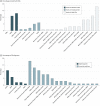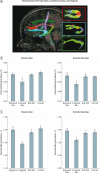White matter structure in youth with behavioral and emotional dysregulation disorders: a probabilistic tractographic study
- PMID: 25715064
- PMCID: PMC4415624
- DOI: 10.1001/jamapsychiatry.2014.2170
White matter structure in youth with behavioral and emotional dysregulation disorders: a probabilistic tractographic study
Abstract
Importance: Psychiatric disorders in youth characterized by behavioral and emotional dysregulation are often comorbid and difficult to distinguish. An alternative approach to conceptualizing these disorders is to move toward a diagnostic system based on underlying pathophysiologic processes that may cut across conventionally defined diagnoses. Neuroimaging techniques have potentials for the identification of these processes.
Objective: To determine whether diffusion imaging, a neuroimaging technique examining white matter (WM) structure, can identify neural correlates of emotional dysregulation in a sample of youth with different psychiatric disorders characterized by behavioral and emotional dysregulation.
Design, setting, and participants: Using global probabilistic tractography, we examined relationships between WM structure in key tracts in emotional regulation circuitry (ie, cingulum, uncinate fasciculus, and forceps minor) and (1) broader diagnostic categories of behavioral and emotional dysregulation disorders (DDs) and (2) symptom dimensions cutting across conventional diagnoses in 120 youth with behavioral and/or emotional DDs, a referred sample of the Longitudinal Assessment of Manic Symptoms (LAM) study. Thirty age- and sex-matched typically developing youth (control participants) were included. Multivariate multiple regression models were used. The study was conducted from July 1, 2010, to February 28, 2014.
Main outcomes and measures: Fractional anisotropy as well as axial and radial diffusivity were estimated and imported into a well-established statistical package. We hypothesized that (1) youth with emotional DDs and those with both behavioral and emotional DDs would show significantly lower fractional anisotropy compared with youth with behavioral DDs in these WM tracts and (2) that there would be significant inverse relationships between dimensional measures of affective symptom severity and fractional anisotropy in these tracts across all participants.
Results: Multivariate multiple regression analyses revealed decreased fractional anisotropy and decreased axial diffusivity within the uncinate fasciculus in youth with emotional DDs vs those with behavioral DDs, those with both DDs, and the controls (F6,160 = 2.4; P = .032; all pairwise comparisons, P < .002). In the same model, greater severity of manic symptoms was positively associated with higher fractional anisotropy across all affected youth (F3,85 = 2.8; P = .044).
Conclusions and relevance: These findings suggest that abnormal uncinate fasciculus and cingulum WM structure may underlie emotional, but not behavioral, dysregulation in pediatric psychiatric disorders and that a different neural mechanism may exist for comorbid emotional and behavioral DDs.
Figures


References
-
- Pavuluri MN, Birmaher B, Naylor MW. Pediatric bipolar disorder: a review of the past 10 years. Journal of the American Academy of Child & Adolescent Psychiatry. 2005;44(9):846–871. - PubMed
-
- Kowatch RA, Youngstrom EA, Danielyan A, Findling RL. Review and meta-analysis of the phenomenology and clinical characteristics of mania in children and adolescents. Bipolar Disorders. 2005;7(6):483–496. - PubMed
-
- Insel T, Cuthbert B, Garvey M, et al. Research domain criteria (RDoC): toward a new classification framework for research on mental disorders. Am J Psychiatry. 2010;167(7):748–751. - PubMed
Publication types
MeSH terms
Grants and funding
LinkOut - more resources
Full Text Sources
Other Literature Sources
Miscellaneous

